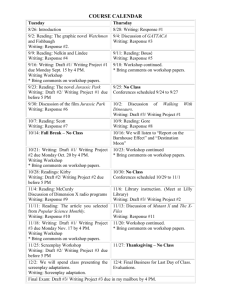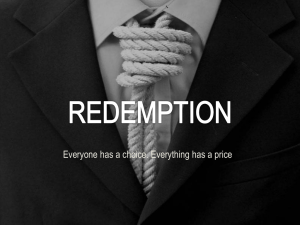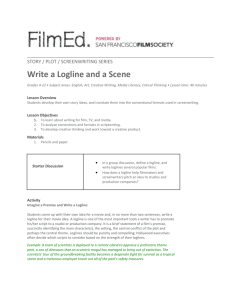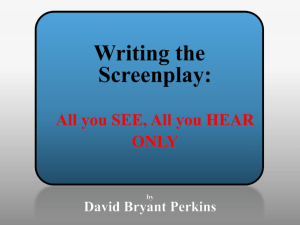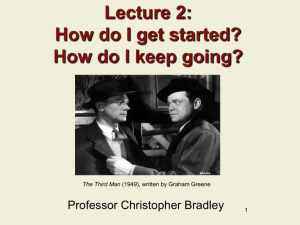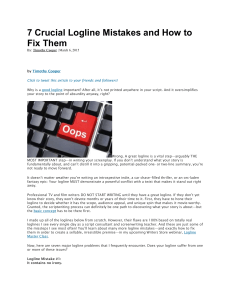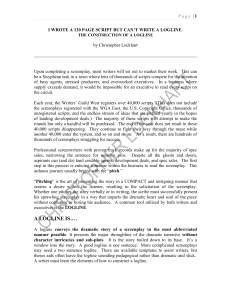Lecture 1b
advertisement
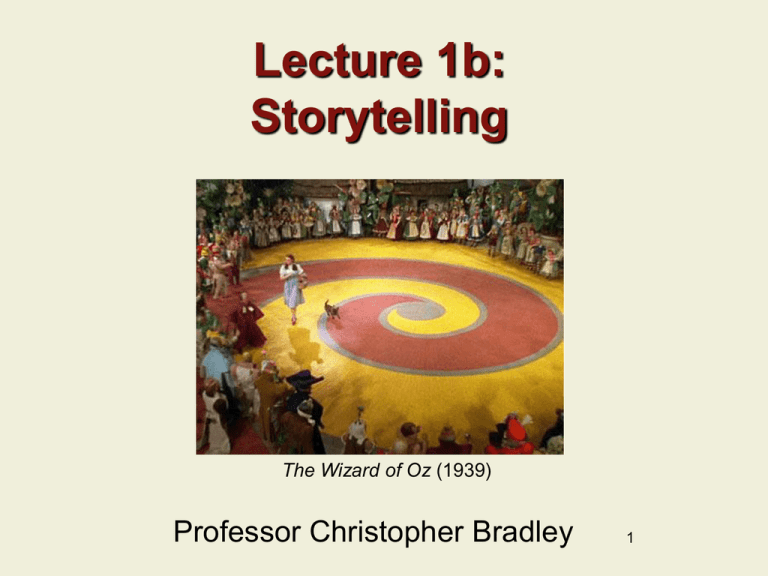
Lecture 1b: Storytelling The Wizard of Oz (1939) Professor Christopher Bradley 1 Previous Lesson • • • • What kind of distance learning course is this? How can you succeed in this course? What do we study in this course? What are the assignments? Thelma & Louise (1991) Written by Callie Khouri 2 In This Lesson • How do I find inspiration? • What is the writing process? • Exercise #1 Shakespeare in Love (1998) Written by Mark Normand and Tom Stoppard 3 Finding Inspiration Disturbia (2007) Written by and Christopher B. Landon and Carl Ellsworth Lesson 1b: Part I 4 Writing is a Challenge • • Aristotle said, “We become brave by performing brave acts.” Every writer, no matter how great or famous, confronts the blank page. Barton Fink (1991) written by Joel & Ethan Coen 5 Meeting the Challenge • • • Meeting the blank page courageously brings endless rewards. The truth can be terrifying. Poltergeist (1982) For example, what might Written by Steven Speilberg your writing reveal about you? (Wouldn’t it be cool to find out?) The more you write, the more you become who you really are. 6 Strategies for Starting • Use your current habits. • When are you most productive? • Associate joy to writing. (It’s Terrific!) • Reward yourself! (A cookie a page?) Written by Orson Welles (1941) 7 Examples of Strategies • Write at the same time each day. • Write at the same place each time. • Before you write, read, watch a film or listen to music that inspires you. • Have everything you need right there so you won’t have to get up. • “Warm up” with “freewriting,” writing whatever comes into your mind. 8 Journal Keeping • Think of a journal as a gold mine. You can go to it again and a gain for inspiration and ideas. • A journal is an excellent place to practice. • You might write down: – Story ideas – Conversations you overhear – Events that made you react passionately 9 The Writing Process Cat People (1982) Written by DeWitt Bodeen, Alan Ormsby and Paul Schrader Lesson 1b: Part II 10 Writing is a Process • Even when great art looks like it “just happened,” but almost without exception, the artist did extensive studies and planning to get that “unplanned” look. • Narrative is like architecture. • There are so many aspects to writing a great screenplay– shaping the story itself, building characters, creating authentic dialog, staying true to the theme– planning is imperative! 11 Steps in the Process • The Story • The Logline • The Treatment • The Step Outline • The First Ten Pages Die Fälscher (The Counterfeiter) (2007) Screenplay by Stefan Ruzowitzky • Rewriting and the Next Twenty Pages 12 Step #1: The Story • Inspirations for writing: – Personal Battles and Victories – Personal Lessons and Losses – The News – Listen! • “Write what you know.” • And find out what you don’t know! 13 The Story • Bring your experience to the table, not as an end, but as a jumping-off place. • Don’t just dictate what happened, reinvent what happened as a metaphor. • Take what actually happened and ask, “What if…?” What if I could bring him back to life? What if I could have controlled that roulette wheel with my mind? 14 Choosing a Subject • Write about what ignites your passion! • Questions that might lead you to a story might include: – What makes you angry? – What makes you terrified? – What do you want very badly? Even if you don’t think it’s possible? – Who made you a different human being? • Freewriting and journaling can help with discover these! 15 Writing in a Genre • Not everything in your writing comes from your own life. Writing movies often involves writing genre stories such as the thriller, Western or romantic comedy. Unforgiven (1992) written by David Webb Peoples 16 The “Size” of Your Story • What is the overall tone of your story? • Is it an epic? • Is it small, intimate and observed in detail? • Pause the lecture and watch the two clips, one from the epic Dances With Wolves, the second from the pilot episode of Grey’s Anatomy. 17 Being Original within a Genre • Copying another movie’s elements can make your story stale. You want a fresh story! • It’s okay to take inspiration from other movies, but ultimately you must add something of yourself to make it interesting. 18 Step #2: The Logline • You should be able to tell your story in three to four sentences. • For example: THE WIZARD OF OZ: A young girl is transported by a cyclone from the drab plains of Kansas to the magical world of Oz. A fraudulent wizard promises to transport the her home if she destroys the great enemy of Oz, the Wicked Witch of the West. She succeeds, but the wizard is unable to make good on his promise. She learns she can transport herself back to Kansas using tools she already has. 19 The Logline Build a logline by asking yourself: 1. What is the conflict or dilemma my protagonist faces? 2. What major complication makes the problem something that seems insurmountable? 3. How does my protagonist overcome the problem (or how is my protagonist defeated by it)? So now you have a beginning, middle & end for your story. 20 Step #3: The Treatment • Think of the Treatment as a short story. You already know the beginning, the middle and the end. • For the first draft of your treatment, tell the story to yourself from start to finish. 21 Give Yourself Room! • A first draft is meant to be the time when you lay out your ideas in rough form. A first draft is generally messy and repetitive and full of mistakes--and that's just fine! Get the basic story and characters down. Get a general idea of how the beginning, middle and end will fit together. The story will likely grow and change in the process. 22 Re-Writing • As you re-write, imagine telling the story to someone else. Does everything make sense? Do your characters’ actions make sense given who they are? Does the story make sense? Does it build to a strong Act Climax? 23 Step #4: The Step Outline • • • Sometimes called a “Beat Sheet” Once you have a completed treatment, you will want to break your story down into beats or steps. Most screenplays have between 35 and 45 beats. 24 The Step Outline - 2 • The Screenplay Structure Guide should be thought of as just that– a guide. Don’t let it restrict you, but do let it guide you. • For instance, the Screenplay Structure Guide says that by about page 4, it should be clear what you’re story is about. If you’re on page 25 and it’s still not clear what your story is about, you may have a problem! 25 The Step Outline - 3 • • You will go through your short story and list each of the events as they happen. If you get to the end and you only have 10 story events, you’ll probably need to expand your story as you likely don’t have enough story for a 110-page screenplay. The guide will help you do this. 26 The Step Outline - 4 • Once you have 35 to 45 steps or events, you’ll look to see how they fall in the story. Have you created Act 1 very thoroughly, but the events are sketchier in Act 2? It will become clear where you need to flesh out your story. 27 Step #5: The First 10 Pages! • In the first 10 pages, you’ll give us your opening hook and we’ll see your character in their “ordinary world.” That is, how they live when they’re not in crisis (as they soon will be). • We’ll see the first ripple of unrest in their world and their unsuccessful attempt to address it. 28 Editing • • • Before you turn in your first 10 pages, carefully examine it for errors in grammar, spelling, or punctuation. This is college-level work. Spell-check will catch a lot, but not everything. Pay attention to Grammar Check, too! Your dialog may be colloquial, but not your action and description! 29 Editing (continued) • We also edit also in the interests of professionalism. You want to see your work produced! Script readers, the gatekeepers for producers, will view an error-filled, badly formatted script as amateur. They won’t finish it! Don’t let poor spelling and/or formatting knock you out of the game! 30 Feedback • You will give constructive feedback to your fellow writers, and they will give constructive feedback to you. • You don’t have to take your classmates’ feedback, but you’ll need to cite examples of several pieces of feedback that you either took or didn’t take, and say why. I need to see you’re taking the feedback you’re receiving seriously! 31 Step #6: The Next 20 Pages • Unrest in your story has built to the first mini-crisis (about page 10). It becomes clear that your protagonist won’t be able to solve their problem with the tools they currently have. Something greater will be required of them. • By or around page 30, they take major action to become the person they need to be in order to address the challenge. 32 Editing • • Again, before you turn in your final pages, check carefully for errors in grammar, spelling, or punctuation. Is your dialog tight? Not padded with unnecessary chatter? Is your description vivid, but spare? Does the story have a strong build? Is the climax of Act 1 gripping? Does it leave your reader needing desperately to know what happens next? 33 A Final Point on Process • • • Keep your standards high! But know that writing is a process of re-writing and refining. Think of writing as sculpture. You continually refine your drafts to create your masterpiece. To be successful with your writing, you must stick with it! You’re in this for the long haul! 34 Assignments Meet the Parents (2000) Screenplay by Jim Herzfeld and John Hamberg Lesson 1b: Part III Reading • Read the chapter “Introduction” in Robert McKee’s Story. Take the selfquiz to be sure you’re clear on what you’ve read! 36 E-Board Post #1 • In the chapter “Introduction,” McKee gives several examples of what story should and should not be. • Post an example of a film that you assert illustrates something McKee says story should be, and an example of what he says it should not be. • Respectfully discuss your classmates’ examples. 37 E-Board Post #2 • Post 3 potential story ideas to the eBoard. • Give your fellow students feedback on their 3 ideas. Which of their ideas is your favorite? Why? 38 End of Lecture 1b The Exorcist (1973) Screenplay by William Peter Blatty Next Lecture: Story Ideas 39
